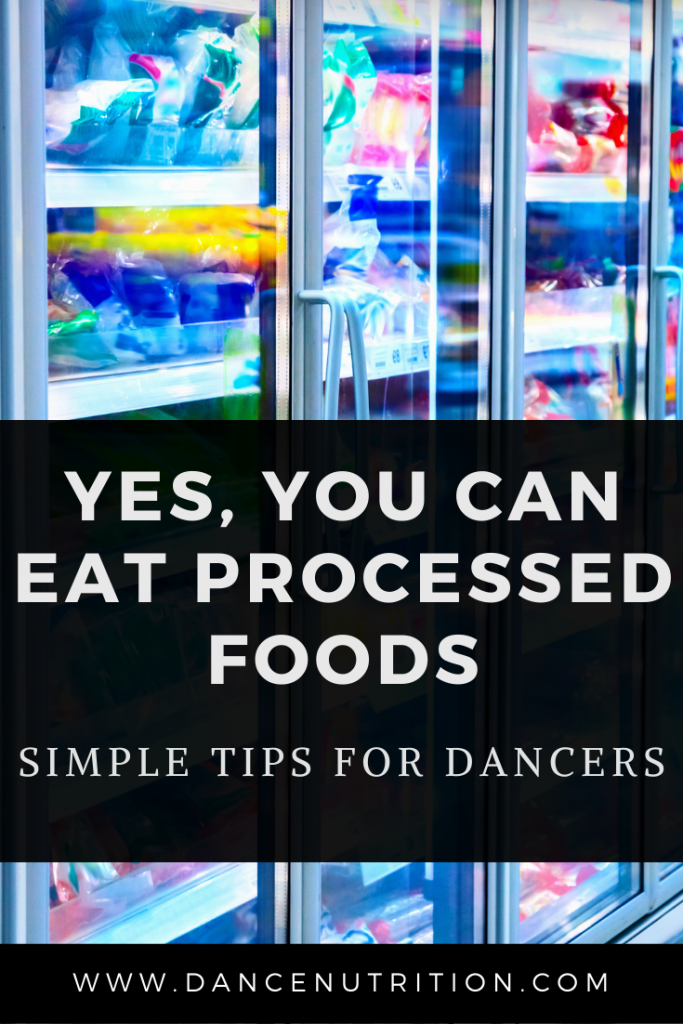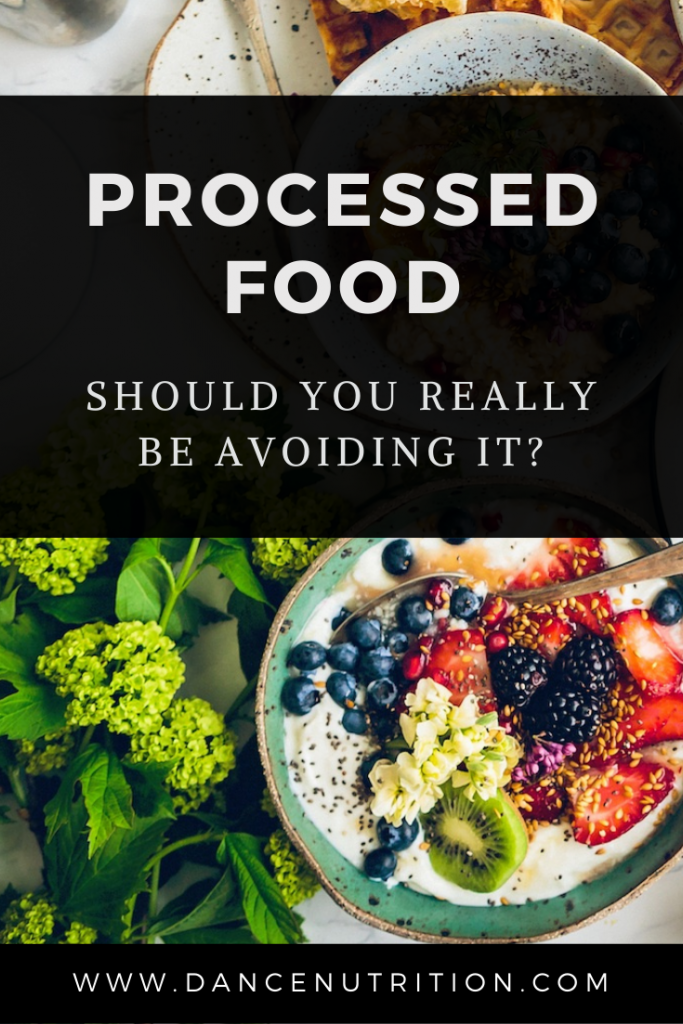Can Dancers Eat Processed Foods?
I’ve previously unraveled the harms of clean eating in an article that you’ll need to read and bookmark ASAP. I’ve even given you three reasons why the idea of “empty calories” is a total sham. But what about processed foods? Should we really be avoiding them?
Advice to “avoid processed food” is unhelpful
Before we break down what it means when a food is processed, I want to first dissect the rhetoric surrounding these foods. Whether it’s “limiting” or “avoiding” processed foods, or, emphasizing that we choose a diet “high in minimally processed foods,” these not-so-subtle nudges of caution categorize food as “good” or “bad.” This language around food is also riddled with guilt, shame, and anxiety- a recipe for disordered eating.
In my 10+ years of experience educating dancers about food, body image, and nutrition, along with my personal history with disordered eating, I can confidently say that this mindset ignites the flames of an unhealthy relationship with food. If you struggle with all-or-nothing thinking and perfectionism, then this advice can lead you into a tunnel of restrictive eating habits.
What is food processing?
Food processing is the mechanical or chemical transformation of agricultural food products from their original state into another form. Food processing improves palatability, increases accessibility, enhances shelf-life, and even reduces the potential for dangerous contamination. Pasteurization is one type of processing that kills harmful bacteria in dairy products and juices. Food fortification and enrichment allow for the addition of micronutrients (like iron, folate, B12, iodine, vitamin C, calcium, and vitamin D) to commonly-consumed products. This has greatly reduced the incidence of micronutrient deficiencies within impoverished communities and those vulnerable to inadequate intakes of vitamins and minerals, such as children, the elderly, and those who are pregnant.
There is a spectrum of how we categorize processed foods (content warning: diet language). from unprocessed or minimally processed to highly processed or ultra-processed. Cooked veggies are an example of a “minimally processed” food while a packaged protein bar or frozen dinner is an example of a highly-processed or “ultra-processed” food. In general, the more processed a food is, the longer the shelf life. This is largely due to the addition of added sugar, sodium, and fat… three very scary words in our culture!
Food processing and added sugar
Yes, there is some research associating an increased consumption of added sugar with an increased prevalence of cardiovascular disease (CVD). But if you dive deeper into that research, you’ll realize that those study participants, specifically those with the lowest risk of CVD, still consume at least the recommended threshold of added sugar (10% of one’s total calories) daily. While I hesitate to give calorie targets to anyone, most research is based upon a 2000-calorie-per-day diet. That means that within the population studied, those with the lowest risk of disease are still consuming up to 5o grams of added sugar each day.
Now, 2000 calories aren’t nearly enough for most of the dancers I work with (you can learn more about calories for dancers here). Without getting too specific about calories, we can translate this research to mean that an active dancer can easily consume over 50 grams of added sugar each day AND STILL BE “HEALTHY.” And FYI… there’s conflicting research about the impacts of added sugar intake on Type 2 Diabetes risk. A recent 2020 study even associated an increase in intake with a decrease in disease risk.
I’m not saying that you should intentionally aim to consume this amount of added sugar each day, but realize that the amounts of added sugar you are consuming from a couple of convenient snacks and even a daily dessert are most likely fine. Here’s an article that dives deeper into sugar and my thoughts on the topic!
Food processing, fat, and sodium
I’ve previously unpacked the myths surrounding fat. And since 2018, the FDA has banned the use of partially hydrogenated oils (the main source of trans fats in our food supply) in packaged foods.
In regards to sodium, the Dietary Guidelines for Americans recommend that adults limit their sodium intake to less than 2,300 mg per day. Since sodium is often added to pre-made foods, frozen foods, and fast food options, a quick consideration would be to aim for 600mg or less per meal and 100-250 mg or less per snack. A few pro tips: drain and rinse canned veggies and add extra frozen veggies to your fast food, takeout, or frozen meals. This will not only help to reduce the sodium load but will also add some extra potassium to your plate.
And remember, these numbers can balance themselves out. If you’re incorporating a variety of foods and including some whole grains and produce throughout your day or week, then you can balance out the higher levels of sodium from a more processed meal or snack.
Are long ingredient lists and unrecognizable ingredients bad?
Ingredients that look like a chemistry exam often stress dancers out. But let’s walk through the variety of ingredients you might find on a label in hopes to uncover why they’re not so stressful.
What are food additives?
According to the World Health Organization, “Food additives are substances added to food to maintain or improve its safety, freshness, taste, texture, or appearance.” Governing bodies throughout the world regulate the additives in their food supply.
The wellness industry often circulates fears that the United States is the culprit in allowing carcinogenic ingredients in our food supply. But there are many additives that are banned in the United States while still available elsewhere and food safety is actually taken very seriously here in the U.S. Though the system has its flaws, regulatory agencies like the FDA are constantly reviewing the research and if needed, recalling potentially dangerous foods from shelves.
“Artificial” vs. “Natural”
Here is a great rundown of the differences between these ingredients. But realize that “natural” colorings or flavors are not always “healthier” or safer than their artificial counterparts. According to the article, “Although natural colors may seem to carry no risk… they have not been tested as thoroughly as artificial colorings.”
Food colorings
Research has been aimed to address concerns that Americans are consuming unsafe levels of food coloring, but the findings do not support these concerns since “exposure to food-color additives in the United States by average and high-intake consumers is well below the acceptable daily intake of each color additive.” (here’s a great article for reference). According to similar results found in 2016 by the FDA, even consumers with the highest levels of intake of food colorings are not at risk for adverse health effects.
Some studies suggest an association between artificial food dyes and hyperactivity in children. In 2007, a study showed that artificial colors and/or the preservative sodium benzoate increased hyperactivity in children. As a result, the European Union began requiring food labels to identify the use of such additives in food.
In 2011 however, the FDA concluded that there was not sufficient evidence proving that artificial colorings caused hyperactivity in the general population. A recent meta-analysis also shows that the data is inconclusive. In opposition to the label requirements in the E.U., the FDA decided a label warning on food packages was unnecessary. So where should you stand?
While some children may respond well to limited food dyes to reduce symptoms of ADHD, it might only be in children with pre-existing hyperactivity— there isn’t enough literature to support a blanket recommendation for avoidance. The decision is individual and therefore, it’s best to talk with your medical doctor and Registered Dietitian Nutritionist before eliminating any foods (even those with dyes) from your diet.
Should I be concerned about Red 40?
As mentioned above, much of the speculation surrounding food dyes like Red 40 lies in their supposed impact on behavior. These speculations date to the 1970s according to Food Insight but haven’t been supported by substantial research— though anecdotal reports suggest the relationship between food dyes and hyperactivity to be true, nobody can say for certain that these dyes directly impact behavior.
Red #3 (also known as erythrosine) is another food dye that gets lots of heat. Early research from the 1980s suggested a possible association between Red #3 and cancer tumor growth in rats, but this was later disproved. This is why unlike in the E.U., the FDA allows for the use of Red #3 in food (even a 2018 joint statement from the United Nations and World Health Organization deemed safe the amounts of Red #3 in the current food supply).
Where can I learn more about food additives?
I’ve learned a lot about food additives from both Christy Harrison and Food Science Bade (I highly encourage you to follow and support them both!). Christy Harrison debunks many of the fears surrounding food additives in her book, The Wellness Trap. Food Science Babe is also an incredible resource when it comes to debunking fears over ingredients like BHT (Butylated hydroxytoluene and high fructose corn syrup. Here are two additional articles from Food Science Babe that I encourage you to read:
- Regulated Food Additives Don’t Deserve To Be Demonized
- The differences between natural and artificial colorings
- The Spread of Misinformation
Dancers and processed foods: Key Takeaways
The cultural emphasis on avoiding processed foods feeds a rhetoric that some foods are “good” and others are “bad” — ultimately, this drives food guilt and creates strained relationships with food. Even if presumed nutrition “experts” and medical professionals are suggesting that you avoid processed food, realize that this advice is archaic and impractical. Processed foods can offer energy when the luxuries of time and money are not accessible— the reality of most of our lives, especially for dancers who are touring, dancing, and downright super busy!
It’s true that eating fast food or ultra-processed foods 100% of the time might not feel too great, physically. But rather than demonizing these options, we can utilize our time in a more productive way— learning how to identify those that might be more nourishing and how to incorporate lesser processed options even when the luxuries of time and money are scarce. There’s a place for nutrition in intuitive eating. If and when a variety of food is accessible, you can apply nutrition knowledge in a non-obsessive way (read more about this here) to build a balanced, nourishing, and sustainable fuel plan. From a public health standpoint, there needs to be more initiative in ending food scarcity and making fresh foods more accessible to all communities (I talk more about this here).
To truly integrate nutrition in a way that doesn’t involve diet culture’s divisive tactics in using food to control your body, it’s important to first dismantle the dieting mentality and make peace with ALL food. In doing so, you strip away the fear, shame, and anxiety around processed foods.




